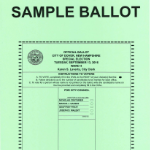
This is related to Bloc Party: Real Representation In Government. That one is concerned with elections where multiple candidates will win, this one is concerned with single candidate elections.
Framed.
When the United States’ Constitution was written, the discipline now called “Political Science” was barely a glint in the milkman’s eye. They had some theory (really more like philosophy) and a very small amount of experience in elections, but were pretty much just wingin’ it.
And they did pretty well, actually; the system is still running over 200 years later, though it’s definitely getting a bit creaky.
No spoilers.
This time, let’s talk about what happens when you have more than one candidate with similar types of appeal in an election.
In what are called “first past the post” systems like used in the United States, this can create a spoiler effect: the less popular of the candidates spoil the chance of the most popular, who could have won without the vote being split among several candidates. The voters get screwed over too, since they can end up with a candidate winning who is very different from what the majority would have chosen.
The common solutuion to this here is the runoff election, where the two biggest finishers compete directly. This kinda works, but it does a poor job of actually reflecting what the voters would choose.
For example:
Take the current Democratic Party primary: Biden is polling highest, though not above 50%, followed by Warren and Sanders who together are often out-polling Biden.
Warren and Sanders are definitely drawing from very similar pools of voters: a significant majority of Sanders’ and Warren’s voters say the other is their second choice.
But with that pool split between two candidates, it’s actually pretty likely that Biden will come out ahead even though he’s expected to get around the same number of votes as the two of them together.
That’s not even getting into tactical voting.
That’s where each voter has to try to guess how everyone else will vote too, in order to try and vote for the best outcome they think they can reasonably expect. In this scenario, it’s likely that some percentage of Biden’s and Sanders’ voters are choosing them for tactical purposes.
Ugh.
Ranked Choice voting systems solve these problems by having each voter rank the candidates in order of preference, then sequentially eliminating the lowest-ranked candidate and shifting their supporters’ votes to their next-ranked candidate.
Based on the current polling, RC would eliminate Warren but since most of her voters would roll to Sanders there’s actually a decent chance that he’d win whereas with the current system he’s probably going to lose to Biden.
Computers can do this stuff really quickly.
The main objection to RC voting systems has always been that they’re sooo complicated, man and that voters get all confused and tabulators can’t cope either.
This is all old hat: ballot designs for RC are well-established now and automated tabulation is common.
There are no more excuses.
Ranked Choice systems give results that better match what the voters actually want out of an election and the systems to do it easily are available.
It’s past time that we required Ranked Choice in all elections where a single candidate is selected.


3 thoughts on “No Spoilers: Ranked Choice Voting”